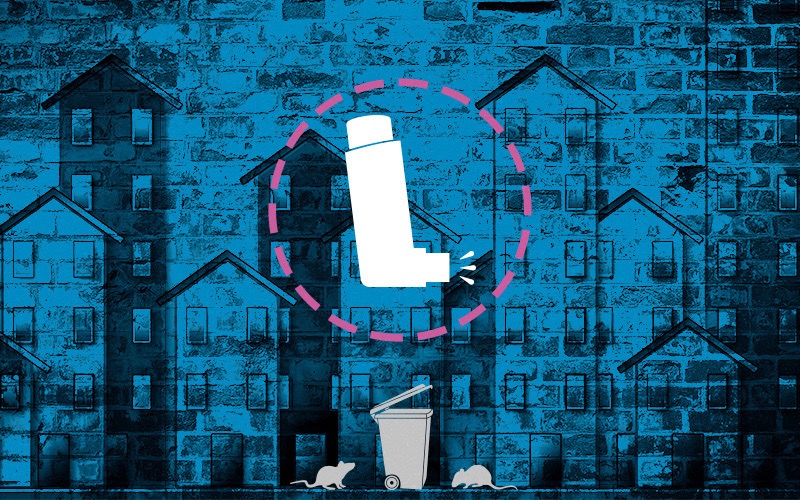Addressing inequities in asthma by focusing on children’s environments

Asthma strikes children in low-income urban areas especially hard, more often sending them to the hospital. For more than 20 years, Dr. Wanda Phipatanakul at Boston Children’s Hospital has been investigating why — and seeking ways to level the playing field.
“Children in low-income areas and children of color often aren’t diagnosed early enough with asthma, and the need for multiple medications can make treatment difficult for families to afford,” she says.
Her passion for reducing asthma inequities is rooted in her own childhood. The daughter of immigrants from Thailand, she grew up in inner-city St. Louis, Missouri, and suffered allergies from early exposures to cockroach and other allergens. Her mother, a fellow allergy sufferer, noted asthma and allergies in other family members and decided to become an allergist. Her daughter followed suit, and today, Dr. Phipatanakul directs the Asthma Clinical Research Center at Boston Children’s.
Intervening in homes
About two decades ago, Dr. Phipatanakul began investigating conditions in the homes and classrooms of children with asthma. Many contained asthma triggers like mold, cigarette smoke, cockroaches, and mice. Could that be remedied?
The Community Asthma Initiative
In parallel with Dr. Phipatanakul’s research, Boston Children’s Community Asthma Initiative serves children in Boston who have visited the emergency department or been hospitalized for asthma. Program staff help families make their homes more “asthma friendly” and access needed services. The program also advocates for government policies to reduce health disparities in asthma, showing that it generates a positive return on investment.
In a pilot study in 2004, her team tested a pest-control intervention. They enrolled 18 families and randomly chose 12 to have home visits from exterminators, who vacuumed, cleaned, sprayed low-toxicity pesticides, set traps, and filled holes and cracks with copper mesh. All 18 families had allergy testing and education about pest-management measures.
Based on an analysis of dust samples, the effort significantly reduced mouse and cockroach allergen levels in the 12 homes. But it was harder to show a reduction in asthma symptoms. The team decided to expand the project.
“What was missing was where every kid spends their day — school,” Dr. Phipatanakul says.
Entering schools and classrooms
In 2008, she launched the School Inner-City Asthma Study, the first U.S. study to look at the effects of school-based allergen exposures. To date, Dr. Phipatanakul and her team have enrolled students at more than three dozen urban elementary schools in the Northeast, monitoring dust samples and children’s asthma symptoms.
As reported in 2017, virtually every school dust sample showed high levels of mouse allergen — much higher than in the children’s homes. The children most exposed at school were 20 percent more likely to have had asthma symptoms in the past two weeks (wheezing, chest tightness, or cough) than children with the least exposure, even after accounting for mouse allergens at home. They also scored lower on a test of lung function.
Another school study focused on mold, finding fungal spores in air samples from every classroom. Children with asthma who tested allergic to mold tended to have more asthma symptoms. During a two-week period, those allergic to one mold, Alternaria, and exposed to high levels at school had more days with asthma symptoms than allergic children exposed to lower levels.
Unhealthy air
The team also zeroed in on air pollution. One investigation, led by Dr. Jonathan Gaffin in the Division of Pulmonary Medicine at Boston Children’s, sampled classrooms for nitrogen dioxide (NO2), and found decreased lung function in children with higher NO2 exposures.
For children who do have reductions in asthma symptoms with environmental interventions, the benefits are as good as those with inhaled corticosteroids, without the side effects.”
Another study, led by Dr. Marissa Hauptman of Boston Children’s Pediatric Environmental Health Center, showed that more than 60 percent of children with asthma attended schools less than 100 meters (328 feet) from a major, heavily trafficked roadway. Forty percent lived within 100 meters of a major roadway. Both groups had worse asthma control and more health care visits than children whose schools and homes were further away from roadways.
“We then sought to do something about these exposures and help these children,” Dr. Phipatanakul says.
School challenges and rewards
In a study published in September, the team combined school pest-management measures with classroom high-efficiency particulate air (HEPA) filter purifiers. Unfortunately, neither significantly reduced the number of days with symptoms over the course of a year in children with asthma.

This was disappointing, but not surprising. Moving the needle is likely to require more extensive interventions — at both home and school — and consideration of the children’s allergen sensitivity, initial asthma severity, and other factors that may affect asthma, like obesity, snoring, and cigarette smoke.
But there was one hopeful finding. Pest management at school did decrease children’s symptoms during the peak time of fall and winter, by about 60 percent.
“For children who do have reductions in asthma symptoms with environmental interventions, the benefits are as good as those with inhaled corticosteroids, without the side effects,” says Dr. Phipatanakul. “We need more resources to keep the benefit sustained.”
She has no plans to give up — not after spending two decades forging partnerships with community groups and schools. Because schools are often hesitant to participate, they aren’t named in the team’s reports.
“Building the relationships we’ve had in the community has taken time,” she says. “It requires deep-rooted work and getting buy-in. If you can intervene in a school, you can benefit a whole community.”
Learn about other current studies at the Asthma Clinical Research Center.
Related Posts :
-

Trial for severe asthma targets a mutation common in children of color
Children and adults of color have higher rates of asthma than white people, as well as more hospitalizations and deaths. ...
-

SMART: A new approach to asthma management
Until recently, the typical approach to asthma involved two inhalers. In its first update since 2007, the National Asthma Education and ...
-

Racial differences in response to asthma therapies, and other AsthmaNet lessons
African Americans have higher rates of serious asthma attacks, hospitalizations, and asthma-related deaths than whites. Now, a large multicenter ...
-

The business case for addressing disparities in asthma
The Community Asthma Initiative (CAI) at Boston Children’s Hospital has been improving the health and quality of life of ...





